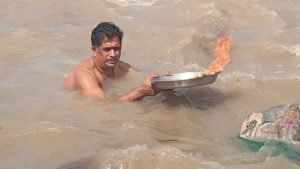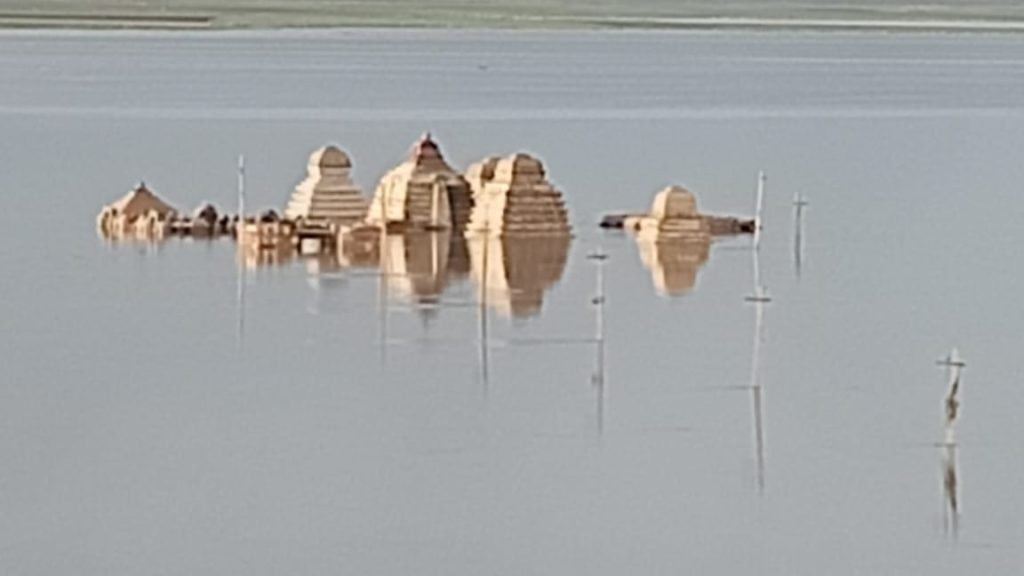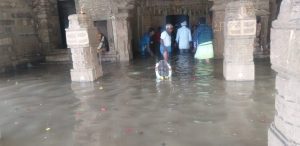
This temple sighting signals drought and misery to Rayalaseema farmers
On July 15, the sacred Sangameshwara temple in Andhra got slowly submerged by overflowing backwaters of the Srisailam reservoir. While devotees mourn the temporary disappearance of the temple, Rayalaseema farmers rejoice over the water

On Friday, July 15, the weather is cloudy. There’s a light drizzle at the beautiful 11th century Nivrutti Sangameshwara temple, located on the fringes of the Nallamala forest, 40 km from Atmakur town in Nadyala district, Andhra Pradesh. The wind blows ominously.
The rising backwaters in the sprawling Srisailam reservoir ferociously dashes against the outer wall of temple. The temple priest Telakapalli Raghurma Sarma hurriedly performs a final puja to Lord Sangameshwara as the surging backwaters are expected to enter the temple at any moment and completely drown the 1,000-year-old captivating structure.

While the puja is in progress, around 3 pm, the water enters the sanctum sanctorum and the holy lingam is covered in water. The priest Sarma, accompanied by his wife, performs the akhanda harati to ‘Krishnamma’.
With a heavy heart, he bids farewell to the Lord, who will be in jaladhivasam (living under water) for over six to eight months. “For a priest it’s sad if he cannot perform his daily puja at the temple but it is iswarechha (will of God). Like the Gods of Kedarnath and Amarnath, Sangameshwarudu will join the natural forces and return after some time, when the water recedes. We cannot change this cycle of natural events,” Sarma tells The Federal.
By evening, except for the gopuram, the entire Sangameshwara temple disappears under the water. By Sunday, there will be no trace of the temple, he says.
Early flooding
According to Sarma, normally the temple goes under water by the end of July. But, this time, flooding has happened so early that people had no time to witness the ‘holy’ event. In another rare occurrence, this year, the event unfolded in the afternoon; the temple usually goes under water at midnight.
“The very thought that I will not visit the temple from tomorrow onwards pierces my heart, but I have to accept the will of the God,” says Sarma, overcome with emotion. But, next year, in March or April, the Lord, after completing the jaladhivasam, will surface from the water to the cheers of local devotees.
Also read: Godavari turns ferocious, record flood expected in next 3 days
Joy of farmers
The submerging of the Sangameshwara temple is not all bad news. For farmers elsewhere in the state, it’s time to rejoice. It is a green signal for them to begin their agricultural operations. Also, this means that they get access to copious water to irrigate the 10 lakh acres of land in Rayalaseema and Nellore districts.
While the priest prays for the Sangameshwara temple to surface soon, the farmers of the backward Rayalaseema region wish for Lord Shiva to remain permanently in jaladhivasam, so that they get adequate water in their fields.
The temple and the jaladhivasam

The Sangameshwaram Temple is particularly sacred because it is the point where River Bhavanasi meets River Krishna. The place is renowned for its ‘Sapta Nadi Sangamam’, where five rivers, namely Veni, Tunga, Bhadra, Bheemarathi and Malapaharini, have already merged with the Krishna at this point, making it a confluence of seven rivers.
This place is revered in the region for these reasons. The lingam here too is unconventionally made out of neem log. The sighting of the temple after the waters recede is considered an auspicious moment and brings peace and prosperity to the region, said the priest.

But, ironically, Rayalaseema farmers view it differently. They feel that when the temple surfaces their conditions turn hostile and they don’t have enough water to irrigate their fields, explains Gopireddy Srinivasa Reddy, a historian from Nandyal.
“The water is drawn from a point called Pothireddypadu, where a regulator has been built. It’s a thumb rule for illiterate farmers that if the temple is submerged in waters, they are assured of water for irrigation from Pothireddypadu. The surfacing of the temple means depletion of water in the reservoir and farmers cannot draw from the Krishna waters. So, for farmers, sighting of the temple means drought, misery, debt and poverty,” says Gopireddy.
No comparison with Himalayan shrines
The submergence and sighting of the Sangameswara temple cannot be compared to the closure of the Himalayan shrines such as Amarnath and Kedarnath during the winter, says Gopireddy. “It has more to do with the politics of water and it happens by a manmade process. It has nothing to do with the natural seasons of the region,” he asserts.
Nagareddy Venkata Subbareddy, a farmer and activist from Nallakalava, a nearby village ,agrees. According to him, the temple remained in water for one-and-half decade after the completion of the Srisailam project in 1981.
“It surfaced as a result of the Government Order (G.O No 69/ dated 16.6.1996), which allowed the drawing of more water from the Srisailam reservoir into the Nagarjuna Sagar Project downstream, which benefits the farmers of coastal Andhra and Telangana. Now, it is with heavy floods alone that the Srisailam reservoir gets water to the brim, enabling Rayalaseema farmers to draw the water. More water flow leads to the submergence of the temple. For the peace and prosperity of Rayalaseema, the farmers here pray for a permanent jaladhivasam for Lord Siva,” Reddy tells The Federal.
Also read: As yields drop, study predicts worse to come for Rayalaseema farmers
Water politics in Andhra Pradesh
At the time of the construction of the Srisailam dam, the Minimum Draw Down Level (MDDL) was fixed at 854 ft water level in the reservoir. Water cannot be drawn below the MDDL of 854 ft.
The level has been fixed to cater to the future water needs of the region, says Bojja Dasaratha Ramireddy, president, Rayalaseema Sagu Neeti Sadhana Samiti (RSNSS). Now, a canal has been constructed to draw water to Chennai and the Rayalaseema region.
“Unless the MDD is maintained at 854 ft, drawing of water to Chennai and Rayalaseema is not possible. But, GO 69 issued by Chandrababu Naidu in 1996 has done great injustice to the region. The GO lowered the MDDL to 834 ft in the name of meeting the irrigation, drinking and power generation needs of downstream Nagarjuna Sagar and Prakasham barrage,” he says, adding that the GO also gave freedom to draw water below the MDDL of 834 ft.
“This denies water to Rayalaseema, whose water drawing point is located at a higher elevation at 847 ft. No political party opposed the GO because of the fear that they would face the wrath of people of coastal areas, which are prosperous and have more seats in the Assembly,” adds Dasaratha Ramireddy.
Change of course
In 2004, after assuming power, Congress Chief Minister YS Rajasekhar Reddy restored the MDDL to 854 ft, issuing a GO (No 107). This also failed to mitigate the woes of Rayalaseema since it tilted the scale towards coastal farmers indirectly.
“Though YSR restored the MDDL to its original level, he left a window to take water down the MDDL if there is an emergency situation in coastal delta region. This has given freedom to the governments to draw more water in the name of power generation and protect the crops in the Guntur district and Krishna delta. The reservoir is being emptied giving no scope to draw water to Rayalaseema region,” says Dasaratha.
Panyam Subramanyam, a former engineer in the irrigation department of united Andhra Pradesh, says Rayalaseema has been victimised on many counts.
Also read: Enraged Rayalaseema farmers demand small dam on Krishna river
“Firstly, the government is not honouring the MDDL at 854 ft. Secondly, even if the water is available during the flood season, the water carrying systems are not modernised to carry enough water to fill balancing reservoirs. Thirdly, the Chandrababu Naidu government between 2014-19 promised to divert the entire share of Krishna water to Rayalaseema once the Pattiseema project, meant to bring Godavari water to the Krishna delta region, was completed,” he explains, pointing out that though Pattiseema was constructed with the support of Rayalaseema people, the diversion of Krishna water to Rayalaseema did not take place.
Unless there are huge flood waters flowing into Srisailam reservoir, chances of Rayalaseema getting water are minimal.
Further, he adds, due to the bias against Rayalaseema, the interests of farmers under Telugu Ganga, Kurnool-Kadapa canal and Srisailam Right Branch Canal (SRBC) are being affected.
Gopireddy summarises the agony of Rayalaseema as he says, “Sangameswaram is the only temple in India whose sight symbolises drought and miseries for lakhs of farmers of the region.”
The story of the Sangameshwara temple
According to historians, the temple was part of a complex called Pancheswaram, built by Rashtrakuta kings and Badami Chalukhyas in the 11th century. The other four temples are Sidheswaram, Kapileswaram, Someswaram and Malleswaram. A few temples that faced the threat of submergence due to the construction of the Srisailam dam have been shifted to Alampur and Kurnool.
The Sangameshwara temple was not relocated as it was found to be architecturally unimportant. The temple was partly demolished and the idol was uprooted. But, at the intervention of Kanchi Paramacharya, the temple was retained and the idol was reinstalled. Earlier, the temple used to be under water for eight months. Now, due to excessive drawl of water for the benefit of downstream areas, the submergence period has come down to six months, which means more dry days for Rayalaseema.


